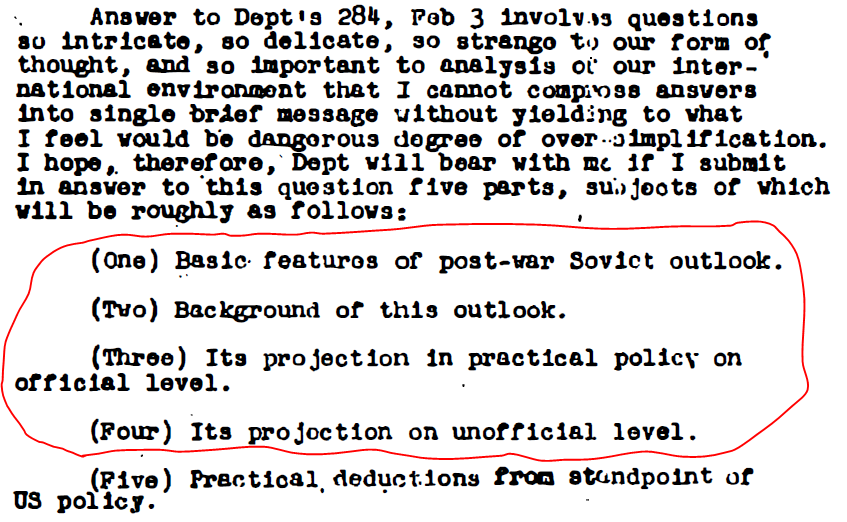
Let's talk about that "Longer Telegram" making the rounds...and why it's a mess.
[THREAD]
atlanticcouncil.org/content-series…
[THREAD]
atlanticcouncil.org/content-series…
First, to be clear, it IS NOT a telegram. It's a report. I mean, it has a flipping 11.5 page executive "summary"... 

...and clocks in at 62 pages (minus the forward and executive summary) or 73 pages (if you include the executive summary).
Of course, the author of "The Longer Telegram" calls it a "telegram" because they want it to be directly and explicitly compared to George Kennan's 1946 "Long Telegram" about US policy towards the Soviet Union.
digitalarchive.wilsoncenter.org/document/11617…
digitalarchive.wilsoncenter.org/document/11617…

But Kennan's "Long Telegram" is called "The Long Telegram" because it was, in fact, a telegram.
Kennan is even apologetic about that fact, as he writes at the beginning, "I apologize in advance for this burdening of telegraphic channel"
Kennan is even apologetic about that fact, as he writes at the beginning, "I apologize in advance for this burdening of telegraphic channel"
Also, Kennan's "Long Telegram" was long for a telegram, but not as a report. It clocks in at 18.5 pages.
Second, the Kennan-obsession of "The Longer Telegram"'s author is also evident by the author choosing to be anonymous. 

The ANONYMOUS writing came a year later (July 1947), when Kennan expanded the telegram into a report that was then published in @ForeignAffairs under the title "The Sources of Soviet Conduct"
Oh, and it wasn't "Anonymous", it was "X"
Oh, and it wasn't "Anonymous", it was "X"

For those keeping track, the FA article was 17 pages.
Third, I love bullet points & numbered lists. I really do (ask anyone who has served on a committee with me). But "The Longer Telegram" is just TOO much.
Nearly every page of the "Executive Summary" is a list.
Nearly every page of the "Executive Summary" is a list.

It doesn't get much better in the report itself.
I mean, here's a page that makes the bold move of transitioning from a bullet point list to a number list....
I mean, here's a page that makes the bold move of transitioning from a bullet point list to a number list....

Now, it's true that Kennan used numbered/lettered lists in his telegram. But that's because it was...again...a TELEGRAM (it also had missing words in spots as is common with telegrams)
Even then, none of the lists had 17 (SEVENTEEN!) points!
Even then, none of the lists had 17 (SEVENTEEN!) points!

Moreover, the FA article version (again, the one that was actually anonymous) had NO bullet points or numbered lists. Just prose and paragraphs (and section headings) 

Fourth, let's move to substance. After all, all of the above is cosmetic and what really matters is the substance, right? Sure, but the substance doesn't make things better in this case.
Let's start by considering the substance of Kennan's telegram.
MOST of it is about the Soviet Union itself. Indeed, 4 of the telegram's 5 parts focus on the USSR.
MOST of it is about the Soviet Union itself. Indeed, 4 of the telegram's 5 parts focus on the USSR.

The final part addresses how the US should respond given the telegram's description of the USSR and its policy.
The key point is that USSR typically backs down when confronted. Therefore, a show of strength & resolve should result in the US never having to actually use force

The key point is that USSR typically backs down when confronted. Therefore, a show of strength & resolve should result in the US never having to actually use force


As for "The Longer Telegram"?
If you're playing buzz-phrase bingo, mark "Liberal International Order"
If you're playing buzz-phrase bingo, mark "Liberal International Order"

I will acknowledge that the Longer Telegram's goal of "keep China in the US order" is distinct from the Long Telegram's recommendation of "keep the Soviets outside the US order".
But this recommendation for US policy towards China is not new.
It's been said better (& more economically) elsewhere.
For example, see this @CarnegieEndow report by @MiraRappHooper, @Michael_S_Chase, Matake Kamiya, Shin Kawashima, & @Yuichi_Hosoya.
carnegieendowment.org/2019/10/10/res…
It's been said better (& more economically) elsewhere.
For example, see this @CarnegieEndow report by @MiraRappHooper, @Michael_S_Chase, Matake Kamiya, Shin Kawashima, & @Yuichi_Hosoya.
carnegieendowment.org/2019/10/10/res…
I'll admit that my assessment of this telegram/report/memo/doorstop is influenced by my own views on the future of US-China relations, which tend toward the "hawkish" side (as I wrote recently in @WarOnTheRocks)
warontherocks.com/2020/10/compet…
warontherocks.com/2020/10/compet…
And I would of course defer to experts on China and Chinese foreign policy (though from what I've seen, they are also NOT IMPRESSED)
https://twitter.com/ehundman/status/1355220955564560385
But, overall, this report/telegram/whatever falls WAY short of it's aspiration of mimicking Kennan.
[END]
[END]
• • •
Missing some Tweet in this thread? You can try to
force a refresh















